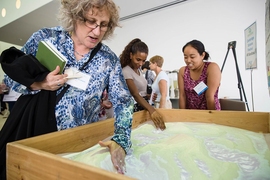MIT President L. Rafael Reif announced today a significant expansion of the Institute’s programs in learning research and online and digital education — from pre-kindergarten through residential higher education and lifelong learning — that fulfills a number of recommendations made in 2014 by the Institute-Wide Task Force on the Future of MIT Education.
Most notably, Reif announced the creation of the MIT Integrated Learning Initiative (MITili), to be led by Professor John Gabrieli, and a new effort to increase MIT’s ability to improve science, technology, engineering, and mathematics (STEM) learning by students from pre-kindergarten through high school (pK-12), to be led by Professor Angela Belcher. The announcement also included a program to support faculty innovations in MIT residential education and new work to enhance MIT’s continuing education programs.
In keeping with the high priority of these new efforts and of the entire field of digital learning, Professor Sanjay Sarma, now dean of digital learning, will oversee them in the newly created position of vice president for open learning, reporting directly to Reif.
Chancellor Cynthia Barnhart, who will share responsibility with Sarma for several aspects of this work, predicts that the programs announced today will have “far-reaching and tremendous implications for education — for MIT students as well as for students not at MIT.”
A set of related FAQs can be found here.
MITili
The integrated science of learning — now emerging as a significant field of research — will be the core of MITili (to be pronounced “mightily”), a cross-disciplinary, Institute-wide initiative to foster rigorous quantitative and qualitative research on how people learn. While many innovative MIT programs have explored new approaches to learning and teaching, Sarma says, “The only thing that was missing was: ‘What’s the science behind it?’”
MITili will combine research in cognitive psychology, neuroscience, economics, engineering, public policy, and other fields to investigate what methods and approaches to education work best for different people and subjects. The effort will also examine how to improve the educational experience within MIT and in the world at large, at all levels of teaching.
“What’s exciting is that technology is making one rethink all the fundamentals of teaching and learning,” says Gabrieli, the Grover M. Hermann Professor in Health Sciences and Technology in the Department of Brain and Cognitive Sciences, who has helped to define the frontiers of learning science. “There’s very little objective evidence that the standard forms of teaching are as effective as they could be.” The new initiative’s research “will look at both fundamental mechanisms of learning that are relevant to education and also be involved in evaluation or assessment of ways in which we think we can improve learning,” he says.
The findings that spin out of MITili will then be applied to improve teaching on campus and online.
“By applying a strong research basis to existing campus efforts in scaling educational access, we can continually improve those learning experiences,” says Professor Eric Klopfer, director of the MIT Scheller Teacher Education Program. “Research can guide those improvements to go well beyond efficiency and investigate ways that we engage more diverse audiences, excite and motivate the public about complex science and engineering concepts, and create generations of inventors and problem solvers. On campus this provides the further benefit of creating a venue where the MIT community can share expertise and improve our own knowledge and skills in this critical domain.”
pK-12
Today’s announcement builds on decades of work by many groups at MIT to strengthen and revitalize learning by students from pre-kindergarten through high school. Dozens of MIT programs exist to serve these students and their teachers, and new efforts continue to emerge, such as the Teaching Systems Lab, established last spring with a $10 million gift from the Woodrow Wilson Foundation, and the Connected Learning Initiative x (CLIx) announced in India last week and funded by the Tata Trusts, which aims to use digital tools to bring active learning experiences to more than 150,000 secondary students in more than 1,000 schools in rural India. The new element added today is a pK-12 faculty advisory committee, chaired by Belcher, that will connect, coordinate, and magnify the impact of the numerous independent initiatives focused on this age group.
“Our collective interest in teaching, outreach, and inspiring the next generation has been the most fulfilling part for me as a member of the MIT community,” says Belcher, who is the James Mason Crafts Professor of Biological Engineering and Materials Science and a member of the Koch Institute of Integrative Cancer Research. “This new effort enables us to amplify, broaden, and accelerate our commitment to pK-12 education at the national level and beyond.”
Adds Mitchel Resnick, the LEGO Professor of Learning Research in the MIT Media Lab and a leader in rethinking education to foster creative thinking and learning: “I love how MIT students are constantly working on creative, collaborative projects driven by their passions. With MIT’s new education initiatives, I’m hoping that we can develop new technologies, activities, and strategies to spread this MIT learning approach around the world, so that people everywhere, of all ages, can learn to think creatively, reason systematically, and work collaboratively.”
Enhancing residential education
Also announced officially today is an important new program to support and enhance the use of digital learning on campus: the MITx Digital Learning Lab. Built gradually over the last three years, the Lab is a group of postdocs, instructors, and lecturers who are enthusiastic about and trained in the use of digital learning tools, so they can work with faculty in their respective disciplines who want to develop new digital materials to make teaching more effective.
Barnhart says that this is one element in a broad effort to “reimagine MIT undergraduate education.” As part of that effort, for example, the Office of the Dean for Undergraduate Education is seeking ambitious proposals linking undergraduate education and the student experience at MIT. Building on work that many people are already doing, she says, the new and expanded programs “will ramp up the number of people who can spend time moving us forward and trying new things, and defining what the undergraduate academic experience will be at MIT, now and in the future.”
The use of digital learning on campus is already well under way through a program called Residential MITx, used so far by 4,800 students in 66 undergraduate and graduate subjects. Over 83 percent of MIT undergraduates have used these online resources in at least one of their classes, and more than 90 professors have made use of the system. Support is overwhelming: For example, 95 percent of students in physics courses that use MITx resources say professors should continue using the system for their classes.
One example of how digital learning tools can enhance residential education comes from recent research comparing outcomes in an introductory class in mechanical engineering, Course 2.01 (Elements of Structures). In the fall semester of 2012, just 10 percent of 2.01 students received a final score over 90. Three years later, with the same professor covering the same material but with the addition of MITx content, the fraction of students scoring over 90 jumped to 56 percent.
Students in these classes, Barnhart says, “use words like ‘transformative’ and say it’s so exciting, they couldn’t stop thinking about it and working on it. Others have said it’s exactly what they thought MIT would be like, to have these kinds of experiences.”
Continuing education
Online continuing education programs for those beyond their college years will also be expanded. “People graduate from college and they assume they’re set for life,” Sarma says. “But given the pace of innovation, really, if you got a computer science degree 10 years ago, are you still prepared for the real world? It’s just a matter of time before every employee at every company is expected to spend some amount of time every week just keeping up with technology. How do we do that efficiently? The same science applies there as well.”
As part of these efforts, MIT is collaborating with Boeing and NASA to launch a Systems Engineering and Architecture Online Program. Consisting of four courses, it will train professionals on models and methods to manage complex systems. Other continuing education online programs include Entrepreneurial Negotiations: The MIT Way and Internet of Things: Roadmap to a Connected World.
Many elements of today’s announcement have been taking shape over the last three years, Sarma says, but they will now be parts of an integrated whole that will help to coordinate the research and the lessons learned.
“I do believe that there are significant changes going on in the way teaching occurs,” Sarma says. “There’s a wonderful quote from Plutarch: ‘The mind is not an empty vessel to be filled, it is a fire to be kindled.’ That’s what we need to be doing.”












